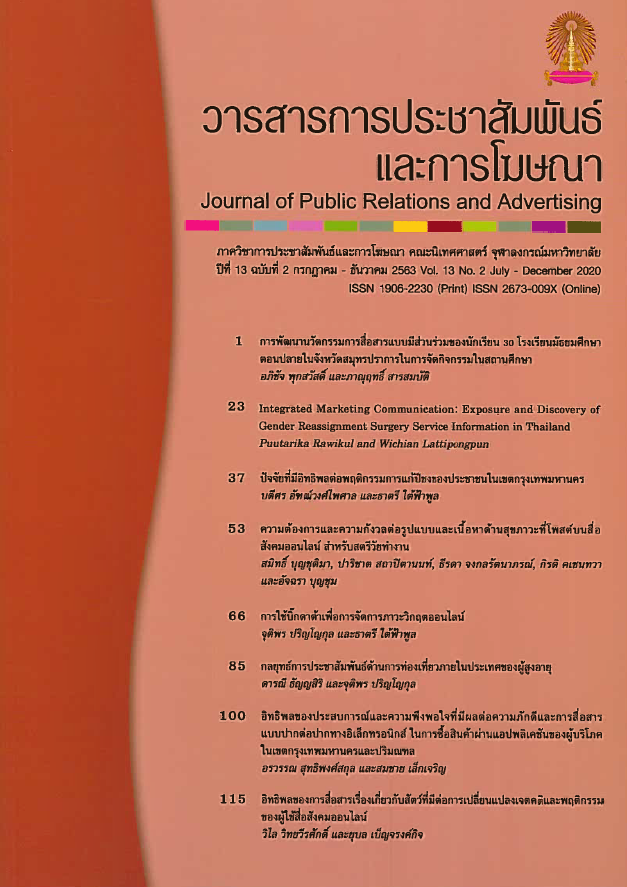อิทธิพลของประสบการณ์และความพึงพอใจที่มีผลต่อความภักดีและการสื่อสาร แบบปากต่อปากทางอิเล็กทรอนิกส์ในการซื้อสินค้าผ่านแอปพลิเคชันของผู้บริโภค ในเขตกรุงเทพมหานครและปริมณฑล
Main Article Content
บทคัดย่อ
การวิจัยครั้งนี้เป็นการวิจัยเชิงสำรวจ โดยมีวัตถุประสงค์เพื่อพัฒนารูปแบบความสัมพันธ์เชิงสาเหตุของปัจจัยที่มีอิทธิพลต่อการสื่อสารแบบปากต่อปากทางอิเล็กทรอนิกส์ในการซื้อสินค้าผ่านแอปพลิเคชันของผู้บริโภคในเขตกรุงเทพมหานครและปริมณฑล และเพื่อตรวจสอบความสอดคล้องของรูปแบบความสัมพันธ์เชิงสาเหตุที่พัฒนาขึ้นกับข้อมูลเชิงประจักษ์ โดยใช้แบบสอบถามออนไลน์เป็นเครื่องมือในการวิจัยและเก็บรวบรวมข้อมูลกับกลุ่มตัวอย่าง ซึ่งเป็นผู้บริโภคที่เคยซื้อสินค้าผ่านแอปพลิเคชันช้อปปี้ และอาศัยอยู่ในเขตกรุงเทพมหานครและปริมณฑล จำนวนรวม 250 คน สถิติที่ใช้ในการวิเคราะห์ข้อมูล ได้แก่ ความถี่ ร้อยละ ค่าเฉลี่ย ส่วนเบี่ยงเบนมาตรฐาน ค่าความเบ้ ค่าความโด่ง และใช้โมเดลสมการโครงสร้างในการวิเคราะห์ความสัมพันธ์เชิงสาเหตุ เพื่อหาเส้นทางอิทธิพลเชิงสาเหตุของตัวแปร จำนวน 4 ด้าน ได้แก่ ด้านความพึงพอใจของลูกค้า ด้านประสบการณ์ของลูกค้า ด้านความภักดีของลูกค้า และด้านการสื่อสารแบบปากต่อปากทางอิเล็กทรอนิกส์ ผลการวิจัยพบว่า รูปแบบความสัมพันธ์เชิงสาเหตุที่พัฒนาขึ้นมีความสอดคล้องกับข้อมูลเชิงประจักษ์เป็นอย่างดี โดยมีค่าสัมประสิทธิ์การพยากรณ์เท่ากับ 0.86 ซึ่งแสดงถึงปัจจัยเชิงสาเหตุ ทั้งด้านความพึงพอใจของลูกค้า ด้านประสบการณ์ของลูกค้า ความภักดีของลูกค้า และด้านการสื่อสารแบบปากต่อปากทางอิเล็กทรอนิกส์ มีความสัมพันธ์เชิงบวกต่อการสื่อสารแบบปากต่อปากทางอิเล็กทรอนิกส์ในการซื้อสินค้าผ่านแอปพลิเคชันของผู้บริโภคในเขตกรุงเทพมหานครและปริมณฑล อย่างมีนัยสำคัญทางสถิติ
Article Details
เอกสารอ้างอิง
กริช แรงสูงเนิน. (2554). การวิเคราะห์ปัจจัยด้วย SPSS และ AMOS เพื่อการวิจัย. กรุงเทพฯ: บริษัท ซีเอ็ดยูเคชั่น จำกัด.
กล้า ตั้งสุวรรณ. (2562). ออกแบบประสบการณ์ลูกค้า พลิกเกมธุรกิจยุค ‘โซเชียล’. วันที่เข้าถึงข้อมูล 26 มีนาคม 2563. แหล่งที่มา https://www.prachachat.net/ict/news-368943.
กิตติชัย ศรีชัยภูมิ. (2556). ความสัมพันธ์ระหว่างประสบการณ์ของลูกค้าวิสาหกิจขนาดเล็กกับความภักดีของตราสินค้าของธนาคารพาณิชย์ในประเทศไทย. ดุษฎีนิพนธ์ คณะบริหารธุรกิจ มหาวิทยาลัยธุรกิจบัณฑิตย์.
ขนิษฐา โฉมอุปฮาด และ บุปผา ลาภะวัฒนาพันธ์. (2559). การบริหารประสบการณ์ของลูกค้าในสถานีบริการน้ำมัน ปตท. วารสารการสื่อสารมวลชน. 4(1), 91-117.
จักรพันธ์ กิตตินรรัตน์ และ จุฑาทิพย์ พหลภาคย์. (2562). คุณภาพบริการกับการสร้างความภักดีของลูกค้า: องค์ประกอบในบริบทของธุรกิจการให้บริการโทรศัพท์เคลื่อนที่ในประเทศไทย. วารสารเศรษฐศาสตร์และกลยุทธ์การจัดการ. 6(1), 135-151.
ชไมพร กาญจนกิจสกุล. (2555). ระเบียบวิธีวิจัยทางสังคมศาสตร์ = Research methodology in social sciences. พิมพ์ครั้งที่ 1. ตาก : โพรเจ็คท์ ไฟฟ์-โฟว์.
ชัยพร ภัทรวารีกุล, วิกานดา ศรีจรัสรุ่ง, และ สันทัด พรประเสริฐมานิต. (2549). การทบทวนงานวิจัยเรื่องความพึงพอใจของผู้บริโภค. คณะจิตวิทยา จุฬาลงกรณ์มหาวิทยาลัย.
ณัฏฐา เกิดช่วย. (2557). ต้นแบบตราสินค้ากับความภักดีต่อตราสินค้าด้านเทคโนโลยี. วิทยานิพนธ์ปริญญามหาบัณฑิต สาขาวิชานิเทศศาสตร์ จุฬาลงกรณ์มหาวิทยาลัย.
ณัฐพัชญ์ วงษ์เหรียญทอง. (2561). 8 สเต็ปของ Customer Experience ที่นักการตลาดควรรู้. วันที่เข้าถึงข้อมูล 26 มีนาคม 2563. แหล่งที่มา https://www.nuttaputch.com/8-steps-of-customer-experience/.
ดารินทร์ จิตสุวรรณ. (2561). อิทธิพลของการสื่อสารปากต่อปากแบบอิเล็กทรอนิกส์ต่อความตั้งใจเลือกใช้บริการโรงแรมที่พักในประเทศไทย. วารสารระบบสารสนเทศด้านธุรกิจ, 4(1), 22-33.
ธนาคารกสิกรไทย. (2561). สร้างประสบการณ์ใหม่ ทอดสะพานมัดใจลูกค้า. วันที่เข้าถึงข้อมูล 26 มีนาคม 2563. แหล่งที่มา https://kasikornbank.com/th/business/sme/KSMEKnowledge/article/MarketingTips/Pages/New-Customer-Experience.aspx.
นงลักษณ์ วิรัชชัย. (2542). โมเดลลิสเรล : สถิติวิเคราะห์สำหรับการวิจัย. (พิมพ์ครั้งที่ 3). กรุงเทพฯ: โรงพิมพ์แห่งจุฬาลงกรณ์มหาวิทยาลัย.
บริษัท ดีมีเตอร์ ไอซีที จำกัด. (2560). “ประสบการณ์ลูกค้า”การแข่งขันของธุรกิจยุคใหม่. วันที่เข้าถึงข้อมูล 26 มีนาคม 2563. แหล่งที่มา https://www.dmit.co.th/th/blog/2017/11/23/why-cx-is-important/
ประชาชาติธุรกิจ ออนไลน์. 2563. TMRW ชูกลยุทธ์ขยายฐานลูกค้าจากการชื่นชอบและบอกต่อ. ข่าวประชาสัมพันธ์. วันที่เข้าถึงข้อมูล 26 มีนาคม 2563 แหล่งที่มา https://www.prachachat.net/public-relations/news-430781.
ปารย์ทิพย์ ธนาภิคุปตานนท์. (2554). ความสัมพันธ์ระหว่างคุณภาพการบริการที่ได้รับกับความพึงพอใจและความภักดีของคนไข้ : กรณีศึกษาโรงพยาบาลเอกชนในเขตกรุงเทพมหานคร. KKU Res. J. 10(2), 160-172.
ปิยะฉัตร พรหมมา. (2556). การเปิดรับข่าวสาร ความผูกพัน และการตอบสนองของผู้บริโภคต่อการสื่อสารผ่านเฟซบุ๊กแฟนเพจ. วิทยานิพนธ์ปริญญามหาบัณฑิต สาขาวิชานิเทศศาสตร์ จุฬาลงกรณ์มหาวิทยาลัย.
พัลลภา ปีติสันต์, ชัญญา เหลี่ยวรุ่งเรือง, สมบุญ เกียรติรุ่งเรืองดี, และ วรวิทย์ ศัลยวุฒิ (2554). การบริหารประสบการณ์ของลูกค้า. วิทยาลัยการจัดการ มหาวิทยาลัยมหิดล.
รพีพรรณ ลีสุวัฒน์, สราวุธ อนันตชาติ, และ สุทธิลักษณ์ หวังสันติธรรม. (2562). ความสัมพันธ์ระหว่างปัจจัยเชิงสาเหตุ ทัศนคติและความตั้งใจในการบอกต่อผ่านสื่ออิเล็กทรอนิกส์ในธุรกิจบริการ. วารสารการประชาสัมพันธ์และการโฆษณา. 13(1), 52-70.
วาทิตา เนื่องนิยม และ วรวรรณ องค์ครุฑรักษา. (2561). การสื่อสารการตลาดแบบบอกต่อ และพฤติกรรมผู้บริโภคร้านอาหารไทยในประเทศโมซัมบิก. คณะนิเทศศาสตร์ จุฬาลงกรณ์มหาวิทยาลัย.
วิเลิศ ภูริวัชร. (2562). การตลาดออนไลน์ปี 2562. วันที่เข้าถึงข้อมูล 26 มีนาคม 2563. แหล่งที่มา https://www.chula.ac.th/cuinside/15785/.
วุฒิไกร ลีวีระพันธุ์. (2562). ชวนพ่อค้า-แม่ค้าไซเบอร์ เติมความรู้เปิดประตูสู่โลกธุรกิจออนไลน์. ข่าวกรม (Press release) 2562. วันที่เข้าถึงข้อมูล 26 มีนาคม 2563. แหล่งที่มา https://www.dbd.go.th/DBD_WEB_/news_view.php?nid=469414910.
สรรพวัต กันตามระ. (2559). 25 ปี ของการศึกษาเรื่องการสื่อสาร แบบปากต่อปาก (Word-of-Mouth). วันที่เข้าถึงข้อมูล 26 มีนาคม 2563. แหล่งที่มา http://www.etatjournal.com/web/menu-read-tat/menu-2016/menu-22016/717-22016-word-of-mouth.
สำนักงานพัฒนาธุรกรรมทางอิเล็กทรอนิกส์ (องค์การมหาชน). (2562). ETDA เผยมูลค่า e-Commerce ไทย โตต่อเนื่อง ยอดปี 2561 พุ่งสูง 3.2 ล้านล้านบาท. วันที่เข้าถึงข้อมูล 26 มีนาคม 2563. แหล่งที่มา https://www.etda.or.th/
content/etda-เผย-อีคอมเมิร์ซ-ไทย-โตต่อเนื่อง-2561-3-2-ล้านล้านบาท.html.
สุชิต ผลเจริญ. (2554). อิทธิพลของการสื่อสารการตลาดแบบปากต่อปาก (Word of Mouth Marketing: WOM). วันที่เข้าถึงข้อมูล 26 มีนาคม 2563 แหล่งที่มา https://www.prthailand.com/images/articles//อิทธิพลของการสื่อสารการตลาด.pdf.
เสรี วงษ์มณฑา. (2542). กลยุทธ์การตลาด การวางแผนการตลาด. กรุงเทพฯ : ธีระฟิล์มและไซเท็กซ์.
Ahmadinejad, A. (2019). The Impact of Customer Satisfaction on Word of Mouth Marketing (Case Study: Bamilo Online Store). SCIREA Journal of Management, 3(2), 40-52.
Bezos, J. (2018). The Journey to Creating Amazing Customer Experiences. Retrieved March 26, 2020, from https://digitalbusinessblog.wordpress.com/2018/01/17/if-you-make-customers-unhappy-in-the-physical-world-they-might-each-tell-6-friends-if-you-make-customers-unhappy-on-the-internet-they-can-each-tell-6000-friends-jeff-bezos/.
Chiguvi, D. and Paul, T. (2017). Impact of Customer Satisfaction on Customer Loyalty in the Banking Sector. International Journal of Scientific Engineering and Research (IJSER), 5(2), 2347-3878.
Cronbach, L. J. (1990). Essentials of psychological testing (5th ed.). New York: Harper Collins Publishers.
Dalia, A. (2016). Essential Elements for Customer Satisfaction. Retrieved March 26, 2020 from https://www.ikf.co.in/blog/essential-elements-for-customer-satisfaction-2019.
East, R., Uncles, M. D., Romaniuk, J., & Hand, C. (2014). The decay of positive and negative word of mouth after product experience. Australasian Marketing Journal (AMJ), 22(4), 350-355.
Ejaz, R., Ahmed, M. A., & Ahmad, Z. (2013). Impact of CRM Practices on Customers’ Behaviors. International Journal of Business and Management Invention, 2(7), 79-88.
Ellyawati, J. (2017). Double Deviation Investigation of Perceived Service Recovery Justice: A Study on The Indonesian Airline Industry. The Journal of Applied Business Research. 33(6), 1263-1272.
Finstad, K. (2010). Response Interpolation and Scale Sensitivity: Evidence Against 5-Point Scales. Journal of Usability Studies. 5(3), 104-110.
Gartner, Inc., (2020). 3 Key Findings From the 2019 Gartner Customer Experience Management Survey. Retrieved March 26, 2020, from https://www.gartner.com/en/marketing/insights/articles/3-key-findings-from-the-2019-gartner-cx-management-survey.
Helgesen, Ø. (2006). Are Loyal Customers Profitable? Customer Satisfaction, Customer Loyalty and Customer Profitability at the Individual Level. Journal of Marketing Management 22(3), 245-266.
Hennig-Thurau, T., Gwinner, K. P., Walsh, G., & Gremler, D. D. (2004). Electronic word-of-mouth via consumer-opinion platforms: What motivates consumers to articulate themselves on the Internet?. Journal of Interactive Marketing, 18(1), 38-52.
Homburg, C., Jozic, D., & Kuehnl, C. (2017). Customer experience management: Toward implementing an evolving marketing concept. Journal of the Academy of Marketing Science. 45, 377–401.
Keller, K. L. (2003). Understanding brands, branding and brand equity. J Direct Data Digit Mark Pract. 5, 7–20.
Kierczak, L. (2020). Customer Satisfaction: 5 Reasons Why is Important in 2020. Retrieved March 26, 2020, from https://survicate.com/customer-satisfaction/importance-customer-satisfaction.
Kotler, P. (2000). Marketing Management. The Millennium edition. New Jersey: Prentic – Hall.
Kozinets, R. V., Valck, K. D., Wojnicki, A., and Wilner, S. S. (2010). Networked Narratives: Understanding Word-of-Mouth Marketing in Online Communities. Retrieved March 26, 2020, from DOI: 10.1509/jmkg. 74.2.71.
Lang, B. & Lawson, R. (2013). Dissecting Word-of-Mouth's Effectiveness and How to Use It as a Proconsumer Tool. Journal of Nonprofit & Public Sector Marketing, 25(4), 374-399.
Porter, M. (2017). WOM Or eWOM, Is There A Difference? : An Extension of the Social Communication Theory to Consumer Purchase Related Attitudes. Retrieved March 26, 2020, from https://digitalcommons.
lsu.edu/gradschool_dissertations/4485.
Rais, N. M., Musa, R., and Muda, M. (2015). Reconceptualisation of Customer Experience Quality (CXQ) Measurement Scale. ScienceDirect. Retrieved March 26, 2020, from https://core.ac.uk/download/pdf/82338163.pdf.
Shoemaker, S. & Lewis, R. C. (1999). Customer loyalty: the future of hospitality marketing. International Journal of Hospitality Management. 18()
The Nielsen Company (US), LLC. (2012). Consumer Trust in Online, Social and Mobile Advertising Grows. Retrieved March 26, 2020, from https://www.nielsen.com/us/en/insights/article/2012/consumer-trust-in-online-social-and-mobile-advertising-grows/.
Zeithaml, V. A. (2000). Service quality, profitability, and the economic worth of customers: What we know and what we need to learn. Journal of the Academy of Marketing Science. 28, 67.


